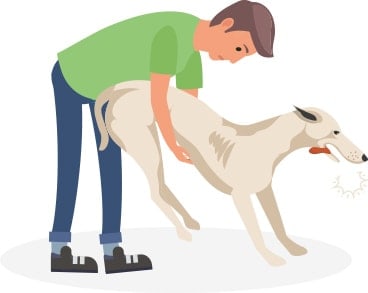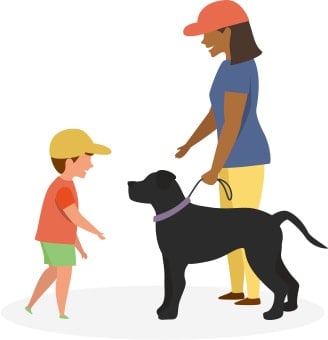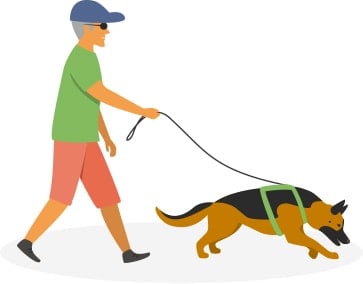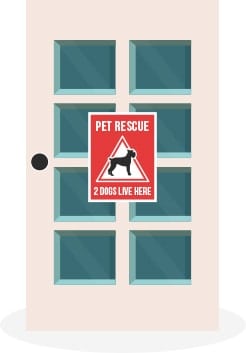Keeping Pets Safe and Secure at Home
Pets are a delight to have in a house, but they are also a huge responsibility. Beyond providing their basic needs like food, water, and shelter, pets also need to be kept safe. And that means keeping an eye on them all the time. Some pets are intrepid, daring, or outrageous. They may be cuddle bunnies at night, but some are escape artists during the day when you leave them home alone.
It’s no easy task keeping a pet safe and happy, but it’s not impossible either. In this guide, let’s discuss pet safety tips from experts and a whole lot of different changes you can make to your house to make it as pet-friendly as possible.
Expert Tip: The best security systems and best security cameras can help keep your pet safe, but not all of them are pet-friendly. See our roundups of the most pet-friendly security systems to know your best options. And for keeping an eye on your pets, see our best security cameras that can double as pet cameras.
View from the Experts on Keeping Pets Safe and Secure at Home
Whip Your Home into Shape
Pets can be extremely curious. Ever seen a kitten with a piece of string? How about a dog trying to figure out what that newly arrived mysterious object is? But there is that famous quote about cats’ curiosity that no pet owner would ever want to come true. So, what we can do to prevent harm and danger befalling our pets is to pet-proof our homes. That means making potentially dangerous home items out of reach or inaccessible to them.
Here are a few ideas:
- Cover trash cans or keep them inside a cabinet that latches.
- Cover heating and air vents.
- Keep toilet lids closed.
- Move or cover wires and electrical cords so pets don’t chew on them. Or, better yet, get a wireless home security system so there are no wires to chew on.
- Block off any holes or small spaces (for example, behind washers and dryers).
- Pick up potential choking and poison hazards before you go out.
- Check spaces that your vacuum can’t access for items such as string.
- Check for pets before you start the dryer or close drawers.
- Clean antifreeze from your floors and driveways immediately.
- Thump your car hood to alert any cats that may have sought shelter in your engine.
If it happens that your cat swallows a string and the string is hanging from Fluffy’s mouth, take the cat to a vet right away. Trying to extract the string yourself could lead to it sawing through intestinal walls, increasing the risk of peritonitis.
Secure the following items so that your pets can’t get to them:
- Makeup
- Lotions
- Medications
- Houseplants
- Laundry Supplies
- Tools & Sharp Objects
- Razors
- Rat Poisons & Traps
- String & Floss
- Tobacco
- Batteries
- Household cleaners
- Chemicals
- Sewing & Craft Items (Including Thread)
- Toys & games
- Food (Wrappers can be harmful as well)
When it comes to dogs, securing an item may mean that you simply keep it high enough or on top of something a dog can’t knock over. As for the bouncing rascals that cats are, securing takes on another dimension. Keep objects attached to walls or floors, or inside containers that cats can’t open with a flick of their paws.
To elaborate on securing your laundry, keep it behind closed doors. Buttons pose a choking hazard, and string/fabric can be harmful as well.
One more thing: Close toilet lids! It’s yucky for your dog or cat to eat toilet water, and the water can make them sick too.
Get Your Yard in Order
Time outside the house can keep your pets happy and healthy. They need it. They need to wriggle, run, and get dirty in the mud. But several outdoor items pose safety risks for pets, so before you let them out, make sure your yard is in order. Here are a few ideas:
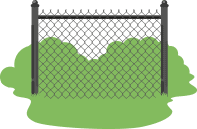 |
Fence carefully. Electronic fences can keep dogs from roaming, but they don’t stop people from coming into your yard. If your dog gets scared easily or bites easily, you may prefer a traditional fence. If you install this type of fence, check that your dog can’t dig under it or jump over it. Look over the fence every once in a while for gaps and holes. | |
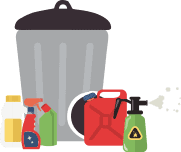 |
Secure trash cans, recycling bins and chemicals. Your dinner leftovers in the trash outside might be toxic for Fido, nor would a snack of bug bait, antifreeze, fuel or cleaning supplies be a good idea. Remember to secure stuff in your garage as well. | |
 |
Put in safe flowers and plants. Daffodils, hyacinths and tulips have alkaloids in their bulbs and can be hazardous to dogs that dig. Similarly, lilies and pollen can be toxic to cats. Check that anything you plant passes the okey-dokey test. | |
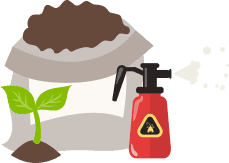 |
Keep pets away from “safe” fertilizers and pesticides until they are dry. As a responsible pet owner, you’re already putting in “safe” fertilizers and pesticides1Good for you! However, they still need to dry before you let your pets loose in the yard. Otherwise, pets could lick these substances or get them in their eyes, leading to neurological issues. In general, avoid fertilizers such as bonemeal and mulch types such as cocoa bean. | |
 |
Clean any bird feeders regularly. Otherwise, accumulated bird feces can result in high bacterial levels, making your pet sick. | |
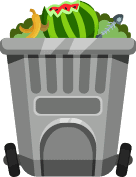 |
Put only dog-friendly objects in compost piles. No corncobs or avocados, and check regularly that your pile isn’t developing mold (mold can make your pet sick). |
A few other tips:
- Two million dogs are stolen in the U.S. every year, and their playtime outside the house could give thieves the opportunity. Invest in a good outdoor security system to keep pet thieves away.
- Ensure ample water and shade for outdoor pets, especially in hot weather. Put any doghouses in the shade.
- Bring rawhide bones inside, and throw them away. Rawhide rots if left outside long enough and can make dogs ill.
- Treat outdoor pets for ticks and fleas, and keep their vaccinations up to date. Also mow and clean your yard, sheds and decks to avoid debris and tall grasses.
- Use a mesh screen to block off decks and porches that have tight crawl spaces.
- Keep small or elderly dogs away from pools and ponds unless the dogs are supervised.
- Keep a pet poison hotline number handy. The ASPCA’s Poison Control number is (888) 426-4435. A consultation fee may apply.
Take Precautions for When You’re Not Home
It’s a rare pet owner who is home 24/7, and the proper precautions help your pet feel safe and secure at home. To learn more, read our complete guide to home security systems.
Enlist Technology
Technology can be your friend in many ways, especially if you work out of the home and want to keep tabs on your pet while you’re away. Here’s how:
- Use a reliable smart lock that can grant electronic keys or entry codes. Give dog walkers or pet sitters their own custom user codes to your house. You’ll get notified when the walker or sitter arrives and leaves.
- Give a key or code to a neighbor you trust in case of an emergency.
- Use monitored, “smart” smoke and carbon monoxide detectors. They could save your pet’s life. Some systems even allow you to open windows and doors from your smartphone to let your pets outside in case of a fire or other emergency. Make sure you get a smart home security system that you can control remotely.
- Keep an eye on your pets with video surveillance. You get to check on them during the day to see how they’re doing, and some systems let you video chat with them. Find out how to buy a home security camera.
- Install “pet-smart” sensors that can tell the difference between a pet who wants to go outside and someone who’s trying to break into your house; outdoor security cameras should come in handy.
If you love smartphone apps, there are plenty to help keep your pet safe.
 |
Pet First Aid by American Red Cross: For dog and cat owners, this app offers how-to videos, step-by-step tutorials and first aid lessons. You can also save pet profiles and your vet’s contact details in the app. |
 |
VetCPD: This app gives you the lowdown on various substances that could be poisonous and how bad they might be. In the home, it covers areas such as garages, kitchens, handbags, personal products, and much more. Interestingly, silica gel is not too bad. At most, it should cause mild gastrointestinal distress. The biggest risk it usually poses is if a pet swallows it and has a foreign body inside. |
 |
Pet Parents — Easy Pet Records: This app helps you keep all of your pet records in one place and stay organized. You can get vaccine and appointment reminders and share info with other caregivers, too. |
 |
Dog Buddy – My Dog File and First Aid (iOS devices only): This app comes in handy for tracking your dog’s health needs, including vaccinations, medications and treatments. Input health data such as your dog’s weight and medication schedules. Android users can download the solid alternative 11Pets, which is available for iOS too. |
There’s also an app called Whistle for Android and iOS. It It enables you to track your pet’s movements and to get alerts when your pet leaves a certain area. It also keeps on top of your pet’s rest and activity times. Basically, it combines GPS and health tracking in one app. You do need companion smart devices such as the Fit, GO Explore, Switch, or Health.
Take Old-Fashioned Measures
Technology is great, but it isn’t everything. Continue to take traditional measures such as pet proofing your home, keeping it at a comfortable temperature and vetting dog walkers and pet sitters to ensure they’ll treat your pet well. (Of course, you can remotely control your home’s temperature with certain smartphone apps!)
Learn Basic First Aid and Emergency Response
To learn basic first aid for pets, you can use apps such as Pet First Aid by American Red Cross. The Red Cross also offers online training2 for cat and dog first aid and gives a rundown of CPR moves.3
In addition, check out the following webpages:
- Supplies for your pet’s first aid kit: Include important paperwork and contact info as well as items such as lightweight medical gauze, nonstick bandages, and digital pet thermometers.
- Basic procedures: What to do if your pet is injured or may have ingested poison, is choking, having a heart attack, bleeding internally or is dealing with other types of health emergencies.
Promote Safe Interactions with Humans
Some pets are social; others, less so. Promoting safe pet-to-pet interactions may look different from one pet household to another, but there are a few ways you can try to get your pets to get along better. And no, we don’t mean confining them together in a small space until they get along. That might work for some children, but that’s the opposite of what you want to do with pets.
With cats, give them their own space to start with, a sort of home base. Other pets, whether cats, dogs or another species, shouldn’t be able to access the space during this introductory period. It’ll be a space that the cat feels connected to in the future and can retreat to when needed.
In general, ask guests and children to take a soft approach and to let your pet set the pace. Good guidelines for anyone, even you, to follow include:
- Stay away from pets when they appear scared or stressed.
- Leave sleeping pets alone, as they may startle if you wake them.
- Leave a pet alone if the pet starts to growl, whine or snap.
- Don’t scream or yell around your pets.
- Approach pets slowly (and leave them slowly—running can provoke the instinctual reaction to chase in some dogs).
- Let pets eat and do their bathroom business in peace.
There’s no shame in keeping your pets separate from guests with a baby gate, crate or closed door if necessary. Just make sure that the space your pet is in is safe (no string, no potential choking hazards, etc.), and check on your furry friend regularly.
If you’re expecting a baby, one way to prepare your dog is to play recorded baby sounds such as an infant crying and to increase the volume for each session. Do this while giving your dog treats so the dog associates the sounds with a good time. A similar principle applies to cats. Also, if the nursery will be in a room the cat uses a lot, introduce decorating changes gradually.
Promote Safe Pet-to-Pet Interactions
Ahh, wouldn’t it be nice if all of your pets got along swimmingly? Instead, each of your cats pretends the others don’t exist. Hey, it could be worse—at least they’re not hurting one another.
Pet interactions in the home can be tricky, and it’s up to you to set the tone. With cats, give them their own space to start with, a sort of home base. Other pets, whether cats, dogs or another species, aren’t able to access the space during this introductory period. It’ll be a space that the cat feels connected to in the future and can retreat to when needed.
In general, high places are your friend with cats because a cat can climb a cat tree or shelf to stay safely away from a dog. High places help a cat observe its surroundings and to feel safe. If you don’t already have a few of these places in your home, creating one can be as simple as putting a cat bed on top of a secured bookshelf.
It’s also important to keep dogs away from cat litterboxes. A dog that eats cat feces could come down with worms, which are intestinal parasites that can cause vomiting, weight loss and anemia. Cats also deserve privacy when they’re using the bathroom. It’s distressing for them to be interrupted or to feel attacked while doing their business. Baby gates are a tactic that can work, but if your dog has a tendency to get through them anyway, keep the litterbox uncovered and in an open area. That way, the cat gets warning that a dog is approaching.
Put Contact Info on Your Animals
Just in case your pet escapes from home or gets stolen, put contact details on your pet’s leash tag. If your pet is unusual-looking, it also helps to have pictures of the pet to show around. Microchipping can also be effective for finding a lost pet.
Use Safe Collars and Harnesses
Cats wearing the wrong type of collar can choke or otherwise injure themselves on their adventures in your house and yard. To keep them safe, opt for collars that are snag-proof or breakaway. Other safety options that may appeal include reflective collars and GPS collars.
Dog collars, too, can pose problems such as strangulation and neck damage. If you have a large property and your dog is outside a lot, choosing the right type of collar becomes even more important. Consider using a harness when walking your dog.
If you have a young pet such as a puppy or kitten, check the pet’s collar at least once a week until the pet reaches adulthood. You should be able to effortlessly insert two or three fingers under the collar. Otherwise, a too-small collar could cause your pet constant, horrible pain.
Plan for Disasters and Emergencies
As touched on earlier, you can use smartphone apps to keep your pet safe in disasters, emergencies and extreme weather. Don’t rely on them solely, though. Steps you can take include:
- Getting a rescue alert sticker for rescue workers at your home—usually on or near the front door
- Planning ahead for evacuation eventualities (where can your pets stay if you cannot evacuate with them? Options may include kennels, friends and the vet)
- Getting travel kits and emergency supplies together
Examples of supplies that could go in a travel kit:
- Scoopable Litter
- Disposable Litter Trays
- Cage Liner
- Extra Leashes
- Blanket
- Flashlight
- Traveling Crate
- Waterproof Container for pet medications & pet food
If you live in an area where tornadoes, hurricanes, floods or earthquakes are likely, take these extra steps:
- Seek shelter on a high floor in case of flooding
- Choose a “safe haven” room that doesn’t have windows and flying debris (e.g. bathroom, basement)
- Prepare a supply of fresh water ahead of time (e.g. filling up a bathtub or storing water jugs in a safe room)
There may be special considerations for your pets depending on their species (bird, horse, reptile, mouse, gerbil, etc.). The bottom of this ASPCA webpage is a good resource.
Take Special Care around Holidays
On certain holidays such as Independence Day and Halloween, it’s a good idea to keep your pets inside and in places where they can’t dart out the door. If you’re going someplace like a fireworks show, don’t bring your dog. Do take the dog for a walk beforehand so it’s tired and worn out if fireworks start going off in the area.
On holidays such as Christmas, Thanksgiving, Halloween and Easter, keep an eye out for string and other loose objects such as candy wrappers that pets can ingest.
Remember Safety and Health for Nontraditional Pets
What if your pet isn’t a cute, fluffy dog, cat or rabbit? Maybe it has no legs, or it lives in water. No problem!
Reptiles and Amphibians
Snakes, turtles, frogs and lizards fall under the category of reptiles and amphibians. Depending on the reptile or amphibian, a living environment reminiscent of a woodland, desert or water environment may be best, and the pet might need hiding spaces or branches and vertical caging to climb.
The pet’s cage should be as large as possible, well-lit and escape-proof. It should also be resistant to heat and moisture.
Birds
Clean birdcages regularly, and select cages that have:
- Comfortable perches
- Bars that are close enough together to prevent your bird from escaping or from getting its head stuck between bars
- Enough space for your bird to live contentedly
Place the cage in a room that stays at a stable temperature, and keep chemicals such as air fresheners, nail polish, candles and even spray-on cooking oil far from birds. The creatures are especially sensitive to them.
Fish
Forget goldfish bowls. They’re too small and confining for your fish to live a healthy life. Instead, your fish deserve as large an aquarium as possible. Then there’s aquarium maintenance. It’s not exactly a barrel of laughs, but filtering the water, regularly changing a quarter of the water in the tank and cleaning out algae are necessary for your fish’s health.
Wow, That’s a Lot of Info!
Despite the amount of information in this guide, keeping your pets safe and secure at home doesn’t have to be complicated. Pet proofing solves most of the puzzle, and if you have a nontraditional pet such as a snake or bird, read specific guides or books that discuss their safety—and yours! For example, a pet turtle could put you at risk for salmonella, and the turtle shouldn’t be in homes with young children and elderly adults.
Happy pet proofing, and soak up all that pet love.
References
- http://npic.orst.edu/health/pets.html
- https://www.redcross.org/take-a-class/first-aid/cat-dog-first-aid
- https://www.redcross.org/take-a-class/cpr/performing-cpr/pet-cpr
Additional Resources
- Pet Safety around the Holidays: Food, decorating, you leaving the house and other issues to consider during the holidays.
- Pets and Poisons: Onions and raisins are bad for your dog and other scoops on pet toxicity.
- Disaster Preparedness: Rescue stickers, travel kits and more.
- Selecting a Pet Reptile: Make an informed decision about whether a reptile is right for you.
- Video Surveillance: The scoop on four cameras to help keep an eye on your pets.





